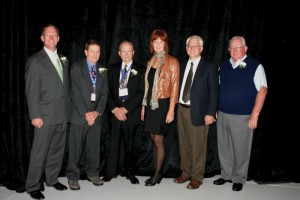OSHKOSH, WIS. – Robert W. Kunkel of Madison, Richard Wixom of Janesville, Jesse Brabazon of Delavan, Richard Lutz of Oshkosh, and Jeannette C. Kapus of Milwaukee were inducted into the Wisconsin Aviation Hall of Fame (WAHF), October 30, 2010, at investiture ceremonies held at the EAA AirVenture Museum, Oshkosh, Wis. This was the organization’s 25th anniversary, since WAHF was founded by former Wisconsin
Bureau of Aeronautics Director Carl E. Guell.
Robert W. Kunkel was born in Montana and was already a pilot when he earned a bachelor’s degree in Civil Engineering in 1966. Commissioned as a Navy Ensign, he served two tours building roads and airports in South Viet Nam.
Kunkel joined the Wisconsin Division of Aeronautics in 1970 as an airport planning engineer, and earned additional pilot ratings through Certified Flight Instructor. He became chief of airport operations, chief airport development engineer, deputy director, and in 1989, director of the Wisconsin Bureau of Aeronautics.
Among his greatest achievements as director were the creation of the satellite-based Weathermation reporting system; the development of 5000-foot runways throughout the state, knowing that is the minimum runway length for most jet aircraft; the Milwaukee heliport system; remote controlled runway lighting; and a pioneering 3D GPS landing system. He was highly regarded for using the airport system he helped to develop by flying aircraft around the state to meet with airport managers and committees.
Kunkel has served on numerous national aviation committees, testified before Congress on federal Airport Improvement Programs, and was elected director and chair of the National Association of State Aviation Officials.
Upon retiring from state service in 2000, Kunkel became a senior aviation consultant for Mead & Hunt, helped develop and publish the “Guide For Managing Small Airports,” and has volunteered one month a year at EAA AirVenture in Oshkosh, Wis., working on everything from the wireless internet system, to escorting dignitaries.
Richard Wixom grew up in Janesville; learned to fly at what is now Southern Wisconsin Regional Airport in Janesville; graduated from Blackhawk Technical Institute in Janesville, earning his airframe and powerplant certificate; flew for Parker Pen Company until they closed their corporate flight department in 1965; and owned and operated Blackhawk Airways from 1971 to 1996, flying parts for General Motors in Twin Beeches. In 1996, Wixom started the Flight Training Center with his son, Kevin, who passed away in 2000.
In retirement, Wixom has donated many hours to raise funds for charitable causes, and serves on the boards of the Staggerwing Foundation and the Wisconsin Aviation Academy in Janesville. In 2005, Wixom received the Wright Brothers Master Pilot Award for 50 consecutive years of safe flying.

Jesse Brabazon of Delavan, Wis. (1885-1969) was a “pioneer” inductee to the hall of fame. He enrolled at Max Little’s flight school in the Chicago suburb of Cicero in 1912, where he became one of the first Wisconsin natives to learn to fly a Wright Brothers Model B two-place aircraft. He relocated to Lima, Ohio to embark on a barnstorming tour of the Midwest, but returned to Wisconsin when the United States entered World War II, at which time he became the oldest pilot in the Civil Air Patrol in Beloit.
Richard Lutz of Oshkosh, Wis. (1896-1965), joined the U.S. Army Air Service as an airplane mechanic in 1917, and in 1919, he traveled to Texas where he bought a JN4-D and barnstormed throughout the oil boomtowns. Lutz returned to Oshkosh in 1920 and started the city’s first airport with fellow pilot, Florian Manor, and the two teamed up to create a wingwalking act, with Lutz on the wing. In 1927, Lutz started a company, bought 100 acres of land on the south edge of Oshkosh, and established the airport that is still there today.
Jeannette C. Kapus of Milwaukee (1920-2009) entered the Civilian Pilot Training Program at the onset of World War II, enlisted and became a Women Air Service Pilot (WASP) in which she ferried aircraft. Following World War II, she became a flight instructor at Timmerman Field and performed in Amvets-sponsored air shows in eastern Wisconsin, setting an official record of 64 spins in light aircraft and an unofficial record of 73 spins. She enlisted in the new U.S. Air Force in 1947, retiring in 1972 as a Lt. Colonel.
